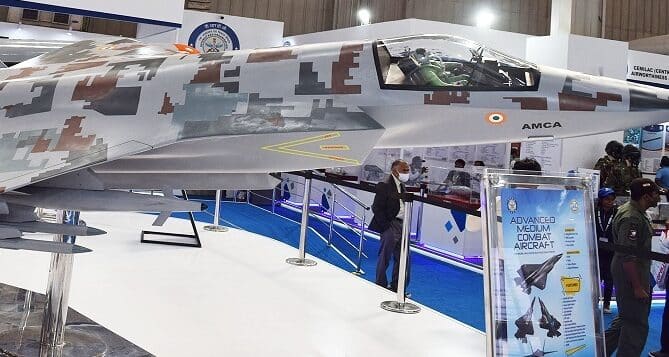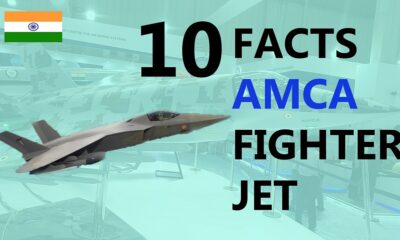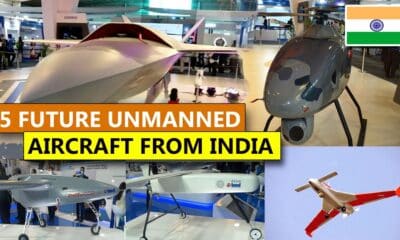Aerospace
By 2028, India’s AMCA fifth-generation fighter jet prototype may fly.
India has been competing with numerous other countries in the development of a fifth-generation fighter jet.

According to representatives of the Aeronautical Development Agency (ADA), a part of India’s Defence Research and Development Organization, the plan then needs approval from the Cabinet Committee on Security (CCS) (DRDO). The CCS will soon approve the AMCA, according to media reports.
“Once the project approval is secured, the first prototype may be put out in three years, and the maiden flight can be in one to one and a half years after that,” AMCA Project Director AK Ghosh said at the just concluded Defence Expo, where a model of the AMCA was shown last week. This timeline indicates that the AMCA will take to the skies for the first time in 2028.
Along with choices about the defense budget, the CCS, which reports to the Cabinet Secretariat, is in charge of making significant appointments and decisions regarding matters of national security.
The CDR attempts to finish the analysis, simulations, drawings, and testing in order to finalize designs.
Most of the indigenous products for the Tejas Mark 2 are also being developed by HAL and DRDO, such as the Pilot ejection seat and the Mid Air Refueling knob, which will aid the AMCA project greatly if they are successful.
The Tejas Mark 2 is slated to fly for the first time early next year, likely concurrently with its involvement in the AMCA, which will be India’s most eagerly anticipated project. Many other nations, including the USA, the UK, and Japan, have expressed a desire to participate in the development. Additionally, engine manufacturers Safran, GE, and Rolls Royce are also interested in collaborating on AMCA projects.
Rolls Royce in talks with DRDO to rev up AMCA engines(Opens in a new browser tab)
The AMCA would be a stealth fighter jet weighing 25 tonnes that had twin engines and an internal weapons bay. A Driverless Supersonic Intake, which was created for the first time in India, will also be included. It is useful to compress the air that prevents Mach speed breach while directing boundary layer airflow away from the aircraft’s engine, doing so without the need for a splitter plate.
The aircraft’s radar cross-section can be reduced by the internal weapons bay, which has a payload capacity of 1500 kg, an exterior payload of 5,500 kg, and an internal fuel capacity of 6,500 kg. This will increase the stealth of the aircraft.

Aerospace
Which is bigger 777x or 787 aircraft ?

The 777X is a new series of the Boeing 777 family and is designed to be larger and more efficient than its predecessor. It features two variants: the 777-8 and the 777-9, being the larger of the two.
The Boeing 777X emerges as the larger sibling within the Boeing family, representing a significant leap forward in both size and efficiency. Comprising two variants, the 777-8 and the 777-9, the latter takes the crown as the larger of the two. With its expansive fuselage and impressive wingspan, the 777X is tailored for long-range journeys and boasts a substantial passenger capacity.
On the other hand, the Boeing 787, affectionately known as the Dreamliner, occupies a niche in the market as a smaller yet formidable aircraft designed for medium to long-range flights. Its distinguishing feature lies in its composite fuselage, a technological marvel that renders it lighter and more fuel-efficient compared to conventional aluminum counterparts. The Boeing 777X is larger than the Boeing 787 aircraft.
When it comes to passenger capacity, the 777-9 reigns supreme, typically accommodating a sizeable contingent of 400-425 passengers in its standard configuration. In contrast, the 787, with its more modest dimensions, typically carries between 240-290 passengers, depending on the variant and layout.
One of the remarkable innovations introduced with the 777X is its folding wingtips, a feature designed to address the logistical challenges of accommodating such a large aircraft in conventional airport gates. These folding wingtips enable the 777X to retract its wings, allowing it to fit into gates designed for smaller aircraft while still reaping the benefits of an extended wingspan during flight, thereby enhancing fuel efficiency and operational flexibility
Aerospace
China Secures Production Certificate for Mass Production of Pilotless eVTOL Aircraft

The first passenger-carrying pilotless electric vertical takeoff and landing (eVTOL) aircraft in the world, the EH216-S, has received the Production Certificate for its eVTOL aircraft from the Civil Aviation Administration of China (CAAC).
This is a significant milestone for EHang Holdings Limited, the leading UAM technology platform company in the world. This outstanding accomplishment is another big step towards mass manufacturing for the eVTOL aircraft and the ensuing commercial operations, building on the ground-breaking acquisition of the Type Certificate and the Standard Airworthiness Certificate for the EH216-S.
The PC is a crucial certificate that the aircraft maker receives from the CAAC, the country’s aviation authority. By obtaining this certificate, EHang has demonstrated that it has set up a quality management system for mass production that satisfies the airworthiness regulation standards set forth by the CAAC, and the company has been given permission to continue producing mass quantities.
It is also a strong guarantee of the calibre of the goods made by EHang. Raw materials, supplier management, manufacturing organisation, production quality control, aircraft pre-delivery test, after-sales repair and maintenance, etc. are all included in the mass production quality management system for the EH216-S.
To ensure that every aircraft and its components that roll off the production line strictly adhere to the approved type design and safety requirements, the system sets clear guidelines and documentation for every step in the production procedure. This ensures comprehensive traceability and safety control.
Aerospace
Four Airbus A380 Superjumbos lined up to be scrapped

In a strategic move aimed at reclaiming valuable resources from the iconic Airbus A380 aircraft, VAS Aero Services and Dr. Peters Group have announced a significant collaboration.
This partnership marks a milestone in aviation logistics and aftermarket services, with four of these colossal planes slated for teardown and redistribution of used serviceable material (USM).
The venture between VAS Aero Services, renowned for its expertise in aircraft dismantlement, and Dr. Peters Group, a prominent Germany-based investment fund management firm, underscores a commitment to sustainable aviation practices. This isn’t their first foray into scrapping A380s; their successful partnership has already seen the dismantlement of these aircraft, making them pioneers in this niche.
Under the agreement, the latest consignment brings the tally to eight A380s entrusted to VAS by Dr. Peters Group. Managing Director Christian Mailly of Dr. Peters Group emphasized the trust placed in VAS, citing their unparalleled capabilities in dismantlement and aftermarket sales network. It’s a strategic move in response to the growing demand for quality USM parts, particularly with the resurgence in reliance on the A380.
Notably, the teardown process will be carried out at various locations, optimizing the positioning of harvested parts to cater to different markets. While some parts will be positioned in Europe to support operators in the region and the Middle East, others will remain in the Asia-Pacific region. This meticulous strategy ensures efficient access to spare parts, benefiting MROs and airlines across these markets.
The decision to retire these A380s comes at a time when operators are reassessing fleet strategies amidst evolving market dynamics. Despite initial plans for quick retirement due to the emergence of more fuel-efficient alternatives, factors such as a rebound in long-haul demand and delays in new widebody deliveries have prompted operators to reconsider. The A380, with its unique capacity and capabilities, presents a practical solution for short-term capacity management.



























